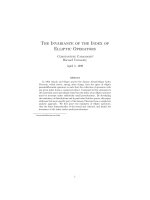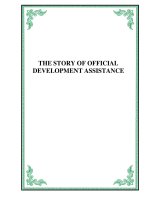Tài liệu The Handbook of EUROPEAN INTELLECTUAL PROPERTY MANAGEMENT pptx
Bạn đang xem bản rút gọn của tài liệu. Xem và tải ngay bản đầy đủ của tài liệu tại đây (2.29 MB, 480 trang )
This page intentionally
left blank
i
This page intentionally
left blank
ii
EUROPEAN
INTELLECTUAL
PROPERTY
MANAGEMENT
The Handbook of
Intellectual Property_HP.qxd 1/6/07 5:20 pm Page 1
This page intentionally
left blank
iv
This page intentionally
left blank
v
This page intentionally
left blank
vi
This page intentionally
left blank
vii
This page intentionally
left blank
viii
This page intentionally
left blank
ix
This page intentionally
left blank
x
ADAM JOLLY & JEREMY PHILPOTT
Developing, Managing and Protecting
your Company’s Intellectual Property
EUROPEAN
INTELLECTUAL
PROPERTY
MANAGEMENT
The Handbook of
London and Philadelphia
In association with
Intellectual Property_TP.qxd 1/6/07 5:32 pm Page 1
Publisher’s note
Every possible effort has been made to ensure that the information contained in this book is accurate
at the time of going to press, and the publishers and authors cannot accept responsibility for any
errors or omissions, however caused. No responsibility for loss or damage occasioned to any person
acting, or refraining from action, as a result of the material in this publication can be accepted by the
editor, the publisher or any of the authors.
The views expressed in this book are those of the authors and are not necessarily the same as those of
the European Patent Office or Kogan Page. The opinions expressed in the book should not be relied
upon as formal legal advice, and proper legal counsel should be sought in relation to intellectual
property matters.
First published in Great Britain and the United States in 2007 by Kogan Page Limited
Apart from any fair dealing for the purposes of research or private study, or criticism or review,
as permitted under the Copyright, Designs and Patents Act 1988, this publication may only be
reproduced, stored or transmitted, in any form or by any means, with the prior permission in writing
of the publishers, or in the case of reprographic reproduction in accordance with the terms and
licences issued by the CLA. Enquiries concerning reproduction outside these terms should be sent to
the publishers at the undermentioned addresses:
120 Pentonville Road 525 South 4th Street, #241
London N1 9JN Philadelphia PA 19147
United Kingdom USA
www.kogan-page.co.uk
© Kogan Page and individual contributors, 2007
The right of Adam Jolly, Jeremy Philpott and the individual contributors to be identified as the
authors of this work has been asserted by them in accordance with the Copyright, Designs and
Patents Act 1988.
ISBN-10 0 7494 4988 8
ISBN-13 978 0 7494 4988 9
British Library Cataloguing-in-Publication Data
A CIP record for this book is available from the British Library.
Library of Congress Cataloging-in-Publication Data
Jolly, Adam.
The handbook of European intellectual property management : developing, managing, and
protecting your company’s intellectual property / Adam Jolly and Jeremy Philpott.
p. cm.
ISBN-13: 978-0-7494-4988-9
ISBN-10: 0-7494-4988-8
1. Intellectual property–Europe. 2. Intellectual property. I. Philpott, Jeremy.
II. Title.
KJC2636.J65 2007
346.2404’8–dc22
2007016444
Typeset by JS Typesetting Ltd, Porthcawl, Mid Glamorgan
Printed and bound in Great Britain by Thanet Press Ltd, Margate
This page intentionally
left blank
xiii
This page intentionally
left blank
xiv
This page intentionally
left blank
xv
This page intentionally
left blank
xvi
Contents
List of acronyms xxxix
Foreword xli
Part 1 A more efficient market for ideas 1
1.1 Europe’s IP architecture 3
Laurent Manderieux, L Bocconi University, Milan
The European Union – but not only the European Union 4; The new
EU-wide integrated IPRS: big success and much use 5; Partly integrated
rights: harmonized rights can sometimes be of real help to companies 6;
The European Patent Organisation: a convenient European alternative
route for obtaining patents 7; What about the future? 8
1.2 The strategic role of IP in European business 14
Ed Round, Marks & Clerk
1.3 IP in the knowledge economy 21
Bo Heiden and Ulf Petrusson, CIP
From blocking to building block 21; Managing (intellectual) assets,
property and capital 22; The transformation to knowledge-based business
models 23; A framework for developing knowledge-based business
models 24
1.4 IP and open innovation 26
Hélène Raybaud and Yves Morel, Schlumberger
Open innovation: the new equation of globalization 26; Open innovation
at Schlumberger 28; IPR and open innovation 28; In conclusion 30
1.5 Managing patents as assets 32
Lars Kellberg, Novo Nordisk
Getting the most valuable patents 32; From core technology to marketing
claims and unique selling points 34; Securing freedom to operate through
an enhanced bargaining position 35; Successful execution is at least as
important as designing the strategy 35; Drafting patent applications for
worldwide protection 36
1.6 Europe’s different IP cultures 39
William Bird, Bird Goën
Part 2 Acquisition of IP rights in Europe 47
2.1 Patents 51
Peter Indahl, International Patent Bureau
Integrate the filing strategy with your business plan 53; Your company
size and position in the market 53; The patent offices available in
Europe 54; Substantive examination or pure registration 55; The first
filing: national or European 55; The first filing: international 56; Quality
of the first filing 56
2.2 Trade marks 57
Gabriella Modiano, Modiano Josif Pisanty & Staub
All roads lead to Europe 57; National filing system 57; The international
trade mark system 60; The CTM system: Europe’s unitary answer 60;
A unitary (and unique) weapon against potential infringers in the
European Union 61; The (positive) fate of historical national trade mark
applications: the creation of ‘seniority’ 62; A single market: use in few
countries, valid in 27 states 62; The expansion of the CTM in an ever-
growing Europe 62
2.3 Copyright in Europe 65
Jan Nilsson, Ström & Gulliksson Intellectual Property Consulting
Copyright protection 65; Legal provisions 66; Rights to a work under
copyright protection 66; Free use of works 67; The copyright symbol
© 67; Legal measures against infringers 67; UK copyright law 68;
French copyright law 69; New developments 69
2.4 Designs 71
Elisabeth Murray, Mathys & Squire
What is a design? 72; Legal protection for designs in the European
Union 72; Protection of designs under the Community Design
Regulation 73; Rights obtained under the Community Design
Regulation 73; Taking action against infringement 74; Benefits of
registration under the Community Design Regulation 74; Applying for
registration 74; When to file 75; Third parties’ rights 75; Summary 76
xviii CONTENTS
________________________________________________________
This page intentionally
left blank
xix
2.5 Utility models 78
Italian Patent and Trademark Office
2.6 Trade secrets 81
Ruth Soetendorp, Centre for Intellectual Property Policy & Management,
Bournemouth University
What is a trade secret? 81; How does a trade secret differ from
confidential information? 84; What information can constitute a trade
secret? 85; How does the law protect trade secrets? 85; International
recognition of trade secret protection 86; Trade secrets and confidential
information – some practical suggestions 87
Part 3 Commercializing IP in Europe 93
3.1 Innovation rights 98
Jean-Louis Somnier, Novagraaf Technologies
Innovation: a holistic view, going beyond technology alone 100; Entering
Europe with an innovation: options for IP rights (IPR) protection 100; IP
protection of an innovation: a critical business decision 101
3.2 Building an international knowledge business 103
Christina Nordström, Swedish Patent and Registration Office
ClimateWell 103; Elekta 105
Feature: international innovation 107
Italian Patent and Trademark Office
3.3 IP and proof of concept 109
Dan Richardson and Dr Paul McEvoy, Technology from Ideas, and
Cathal Lane, Tomkins & Co
Environment and people 109; Sourcing ideas 110; Selection/filtering 110;
Development 112; Key activities 113; Sale 115; Summary and future
trends 115
3.4 Business–university collaboration 117
Lawrence Cullen, UK Intellectual Property Office
Purpose 118; The Toolkit 118; Using the Toolkit 124; Use of the
Toolkit 125; Recent updates 126; Collaboration in Europe 126; The
future: business-to-business model agreements 126; Conclusion 128
3.5 Managing IP in collaborative ventures 129
Martin A Bader, BGW AG Management Advisory Group
Collaboration = dilution of intellectual assets? 129; Collaborative success
factors 130; Conclusions 133
xx CONTENTS
_________________________________________________________
This page intentionally
left blank
xxi
3.6 Licensing as a growth strategy in Europe 135
Martin Sandford, Licensing Executives Society, Great Britain & Ireland
Risk perspective 135; Intellectual property (IP) 136; What is a licence?
137; Licensee selection 137; Common pitfalls – what can go wrong 137;
When would licensing be inappropriate? 138; Conclusions 138
3.7 Innovation support in the new Europe 139
Éva Bakos and András Haszonits, Hungarian Patent Office
Situation of Hungarian SMEs according to the VIVACE Survey
2006 140; Economic incentives for innovation and the application of
IPR 143; The VIVACE programme 145; Conclusions 145
Part 4 Technology and patents 147
4.1 Creating a patent position in Europe 152
Alan Senior, J A Kemp & Co
The building blocks 154; Litigation 155; Building a position with the
blocks 156
4.2 European patents: differences from the United States 163
Timothy J May and Beth Z Shaw, Finnegan Henderson
Introduction 163; Filing and prosecuting patent applications in the
United States and Europe 164; Post-grant procedures 166; Litigation/
enforcement 167
4.3 Prior art searching 169
Dean Parry, Patent Seekers
It’s a complex system 169; The standard route to gaining a patent 169;
How does a patent office process your patent application? 170; Common
misconceptions 172; Light at the end of the tunnel 172; A few helpful
suggestions 172
Feature: Assisted patent searches 175
Professor Heinz Muller and Dr Alban Fischer, Swiss Federal Institute of
Intellectual Property
4.4 Portfolio building 179
Sue Scott, Abel & Imray
How to develop your filing strategy 179; In which countries should you
file patent applications? 180; The value of different types of claim 182;
Claim types: a pharmaceutical case study 182; Portfolio review 185;
Conclusion 186
xxii CONTENTS
________________________________________________________
This page intentionally
left blank
xxiii
4.5 Patent exceptions 187
John Brunner and James Warner, Carpmaels & Ransford
Medical inventions at the EPO 188; Computer software at the EPO 189;
Patents for plant and animal varieties at the EPO 190; Summary 192
4.6 Patent clearances 194
Micaela Modiano, Modiano Josif Pisanty & Staub
European opposition: a single procedure and a single result 195;
Third party observations: steering prosecution at no cost 196; Double
attack 196; Summary 197
4.7 Patents on a budget 198
Keith Loven, Loven & Co
Do you have an invention? 198; Do you need a patent? 200; Decide on a
sensible patenting strategy 201
Part 5 Creative and digital rights 207
5.1 Issues in European copyright 209
Andrew Yeates, Sheridans
The benefit of flexibility for copyright 209; To harmonize or not to
harmonize, that is the question 210; Gowers Review of Intellectual
Property 211; Summary 213
5.2 Copyright and the digital economy 215
Emanuel Meyer, Swiss Federal Institute of Intellectual Property
5.3 Digital policy management 221
Mark Isherwood, Rightscom
Defining the problem 221; Digital policy management 222; Some DPM
building blocks 223; Standards development and interoperability 224
5.4 Digital distribution and Creative Commons 226
Paula le Dieu, Magic Lantern Productions
Copyright – the Swiss army knife of distribution tools 226; Creative
Commons – some rights reserved 227; Magnatunes 228; DRM – the
sledgehammer of distribution tools 228
Part 6 Brands and trade marks 231
6.1 Taking products and services to market across Europe 236
Brian Morgan and Esther Gottschalk, Marks & Clerk
Before a launch 237; After a launch 238
xxiv CONTENTS
________________________________________________________
6.2 Managing brand and design portfolios in Europe 240
Silas Brown, Briffa
Trade mark protection 241; Registered designs 242; A balance of risks
243; Conclusion 244
6.3 Building a strong (European) trade mark 246
Sofia Arenal, Mewburn Ellis LLP
Selection 246; Registration 248; Beyond registration 250
6.4 Defending brands 252
Lisa Lovell, Brand Enforcement
Awareness 252; Intelligence 254; Enforcement 255; Periodically revise
your IP enforcement strategy 255; The benefits of implementing a
consistent IP enforcement strategy 256
Part 7 Company knowledge 261
7.1 Intellectual assets management 263
Iain Russell, Intellectual Assets Centre
The knowledge gap 263; Why is this important to businesses? 263;
Why are these assets ‘hidden’ and does it matter? 265; Why focus on
IA management and what does it encompass? 265; How to manage
intellectual assets 266; How to measure and communicate value 267;
Which approach should be adopted? 269; What about the future? 269
7.2 Inventions by employees 270
Walter Holzer, GMX
7.3 IP and the web 274
Silas Brown, Briffa
Trade marks on the web 274; Master of your domain 275; Digital content
on the web 276; Conclusion 278
7.4 Database rights 280
Robert Lands, Finers Stephens Innocent LLP
The database right 281; The British Horseracing Board case 282
Part 8 IP as an asset 285
8.1 Valuing IP, intangibles and goodwill 287
Kelvin King, Valuation Consulting
Relevant accounting standards 288; Corporate governance 289; IPR
and the valuation expert 289; Methods for the valuation of IPR 290;
Conclusion 292
________________________________________________________
CONTENTS xxv









